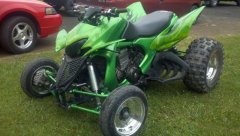-
Similar Forum Topics
-
By skittle021
So I've got a Hisun 550 that I was doing some work on that required removing the CVT and it's housing. Upon attempting to reinstall the clutch, sheaves, etc, I found that the belt no longer fits - it's far too wide. None of the parts have been replaced, they're all OEM. Exactly the same parts as what I took off a few weeks ago.
To be more specific, my belt is 1.25in wide, but the gap between the clutch and the primary sheave is only 7/8in wide. I'll include a few photos to explain.
Has anyone ever experienced such a bizarre problem? Any help at all would be appreciated, I've been stuck on this for a month. I'm open to just about any suggestion.
Photos:
-
By p5200
I'm having trouble identifying Mark. I know where the mark is in the Stator cover. Is the T at about, the 12 o'clock position in this photo? I've got to buy another Stator cover as the one I have has a hole at the bottom of it. Due to failing eyes, I have a lot of trouble anymore. Thanks! 🙂
-
By Mhatayas
So here where I live in Newfoundland Canada, they let you drive your bike on the road provided it’s registered and insured same goes for crossing highways but on trails you don’t need to be insured. And I don’t even think you need a full license to insure your bike they said it was up to the insurance company. I’m trying to get my old 1985 Suzuki 250 registered they have to do a search for it to make sure it hasn’t been in anyone else’s name first. Hopefully it comes back clean I am pretty excited
-
By skittle021
So I've got a Hisun 550 (clone of a Yamaha Rhino 660) that I was doing some work on that required removing the CVT and it's housing. Upon attempting to reinstall the clutch, sheaves, etc, I found that the belt no longer fits - it's far too wide. None of the parts have been replaced, they're all OEM. Exactly the same parts as what I took off a few weeks ago.
To be more specific, my belt is 1.25in wide, but the gap between the clutch and the primary sheave is only 7/8in wide. I'll include a few photos to explain.
Has anyone ever experienced such a bizarre problem? Any help at all would be appreciated, I've been stuck on this for a month. I'm open to just about any suggestion.
Photos:

-
By cosmacart
Hi all, iam from ohio and i have a 2013 yamaha rhino SE black . I might sell it but i dont know what its worth. So can anyone give me an idea what to ask for it?? This is not a scam,,its only a question thanks in advance!!
-





Recommended Posts
Join the conversation
You can post now and register later. If you have an account, sign in now to post with your account.
Note: Your post will require moderator approval before it will be visible.